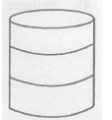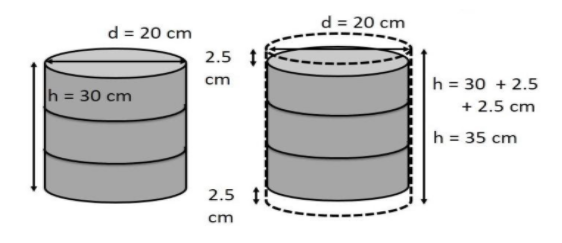
In the figure, you see the frame of a lampshade. It is to be covered with a decorative cloth. The frame has a base diameter of 20 cm and height of 30 cm. A margin of 2.5 cm is to be given for folding it over the top and bottom of the frame. How much cloth is required for making lampshade?


Answer
577.5k+ views
Hint:The lampshade is in the shape of a cylinder. Find the curved surface area of the cylinder by increasing the height for the cloth.
Formula used: Curved surface area of the cylinder is \[2\pi rh\] , where $\pi = \dfrac{{22}}{7}$ , r is the radius of the base of the cylinder, h is the height of the cylinder.
Complete step-by-step solution:
Given the base diameter of the lampshade is 20cm, height of the lampshade is 30cm and extra 2.5cm of the cloth is required for folding it over the top and bottom of the frame.
So the height of the lampshade is increased by 2.5cm top and 2.5cm bottom.

So, from the above figure the final height of the lampshade will be $30cm + 2.5cm + 2.5cm = 35cm$
Given diameter of the base is \[20cm\]
Radius = half of the diameter= $\dfrac{{20}}{2} = 10cm$
So, finally we have all the required values i.e. \[r = 10cm,{\text{ }}h = 35cm.\]
Curved surface area of the cylinder = $2\pi rh$
\[
= 2 \times \dfrac{{22}}{7} \times 10 \times 35 \\
= 2 \times \dfrac{{22}}{{{{7}}}} \times 10 \times 3{{5}} \\
= 2 \times 22 \times 10 \times 5 \\
= 2200c{m^2} \\
\]
Therefore, 2200 square centimeters of the cloth is required for making the lampshade.
Note: Do not get confused with the curved surface area and total surface area. Total surface area of the cylinder includes the two ends of the cylinders which are circular planes whereas the curved surface area of the cylinder is the area along the curvature of the cylinder body.
Total surface area= Curved surface area + 2(area of circle)
$
= 2\pi rh + 2\left( {\pi {r^2}} \right) \\
= 2\pi rh + 2\pi {r^2} \\
= 2\pi r\left( {h + r} \right) \\
$
Formula used: Curved surface area of the cylinder is \[2\pi rh\] , where $\pi = \dfrac{{22}}{7}$ , r is the radius of the base of the cylinder, h is the height of the cylinder.
Complete step-by-step solution:
Given the base diameter of the lampshade is 20cm, height of the lampshade is 30cm and extra 2.5cm of the cloth is required for folding it over the top and bottom of the frame.
So the height of the lampshade is increased by 2.5cm top and 2.5cm bottom.

So, from the above figure the final height of the lampshade will be $30cm + 2.5cm + 2.5cm = 35cm$
Given diameter of the base is \[20cm\]
Radius = half of the diameter= $\dfrac{{20}}{2} = 10cm$
So, finally we have all the required values i.e. \[r = 10cm,{\text{ }}h = 35cm.\]
Curved surface area of the cylinder = $2\pi rh$
\[
= 2 \times \dfrac{{22}}{7} \times 10 \times 35 \\
= 2 \times \dfrac{{22}}{{{{7}}}} \times 10 \times 3{{5}} \\
= 2 \times 22 \times 10 \times 5 \\
= 2200c{m^2} \\
\]
Therefore, 2200 square centimeters of the cloth is required for making the lampshade.
Note: Do not get confused with the curved surface area and total surface area. Total surface area of the cylinder includes the two ends of the cylinders which are circular planes whereas the curved surface area of the cylinder is the area along the curvature of the cylinder body.
Total surface area= Curved surface area + 2(area of circle)
$
= 2\pi rh + 2\left( {\pi {r^2}} \right) \\
= 2\pi rh + 2\pi {r^2} \\
= 2\pi r\left( {h + r} \right) \\
$
Recently Updated Pages
Two men on either side of the cliff 90m height observe class 10 maths CBSE

What happens to glucose which enters nephron along class 10 biology CBSE

Cutting of the Chinese melon means A The business and class 10 social science CBSE

Write a dialogue with at least ten utterances between class 10 english CBSE

Show an aquatic food chain using the following organisms class 10 biology CBSE

A circle is inscribed in an equilateral triangle and class 10 maths CBSE

Trending doubts
Why is there a time difference of about 5 hours between class 10 social science CBSE

Write a letter to the principal requesting him to grant class 10 english CBSE

What is the median of the first 10 natural numbers class 10 maths CBSE

The Equation xxx + 2 is Satisfied when x is Equal to Class 10 Maths

Which of the following does not have a fundamental class 10 physics CBSE

State and prove converse of BPT Basic Proportionality class 10 maths CBSE




